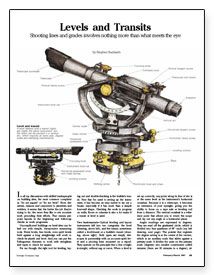Levels and Transits
Shooting lines and grades involves nothing more than what meets the eye.

Synopsis: Despite the rising availability of laser tools, many builders continue to use conventional levels and transits for laying out buildings. This article describes these tools and offers tips on using them correctly. It includes an annotated list of manufacturers.
In all my discussions with skilled tradespeople on building sites, the most common complaint is, “it’s not square” or “it’s not level.” From tile setters, masons and carpenters to plumbers and welders, it seems that the better the job they’re trying to do, the more they like to see accurate work preceding their efforts. That means pinpoint layouts in the beginning and follow-up checks as work progresses.
Uncomplicated buildings on level sites can be laid out with simple, inexpensive measuring tools. Water levels, line levels, even spirit levels held against a long straightedge will work to check for plumb and level. And you can put the Pythagorean theorem to work with string lines and tapes to check for square.
For me though, the right tool for leveling, laying out and double-checking is the builder’s transit. Now that I’m used to setting up the instrument, it has become an easy matter to lay out a house, especially if it has more than a simple four-wall shape. Checking the work in progress on walls, floors or columns is also a lot easier if a transit or level is used.
Two instruments
Optical leveling and layout instruments fall into two categories: the level, and the transit, sometimes called a level-transit or a builder’s transit. Both types are simply telescopes in partnership with an accurate spirit level and a pivoting base mounted on a tripod. They operate on the principle that a line of sight is straight, without sag or curve. When a level is set up correctly, any point along its line of site is at the same level as the instrument’s horizontal crosshair. Because it is a telescope, it becomes an extension of your eyesight, giving you the ability to focus on a tape rule or leveling rod from a distance. The vertical crosshair is a reference point that allows you to rotate the scope and lay out any angle in a horizontal plane.
Angle readings are expressed in degrees. They are read off the graduated circle, which is divided into four quadrants of 90° each. The pointer that registers the degree setting is at the center of the vernier, which is an auxiliary scale that slides against a primary scale. It divides the units on the primary scale (degrees) into smaller constituents called minutes (there are 60 minutes in a degree), allowing very precise readings to be made. On my Realist builder’s transit, the vernier is divided into five-minute segments.
For more photos, drawings, and details, click the View PDF button below:
Fine Homebuilding Recommended Products
Fine Homebuilding receives a commission for items purchased through links on this site, including Amazon Associates and other affiliate advertising programs.

All New Kitchen Ideas that Work

A Field Guide to American Houses

Smart String Line


























